ikfoundation.org
The IK Foundation
Promoting Natural & Cultural History
Since 1988


CARNATIONS, TULIPS AND MAGNOLIAS
– English Embroideries from 1735 to 1745
Anemones, carnations, tulips, magnolias, peonies – seeds and bulbs of these plants had already been imported from overseas to England during the 16th century. Initially, it was for the most prosperous landowners’ gardens, but when time passed, seeds and bulbs were given to others, and they became well-established desirable flowering plants in the Georgian Era. A fashion that can be traced via artwork, pottery, botanical plates, herbaria, decorative paper-cuts, notations in correspondence or from contemporary books as well as for designs on canvas-worked wool and silk embroideries, which will be looked at more closely via three pieces of furniture with original upholstery still intact. Over the years, I have revisited the David Collection in Copenhagen (København), where these mid-18th century embroideries are on display in the furnished rooms of European 18th Century Art.
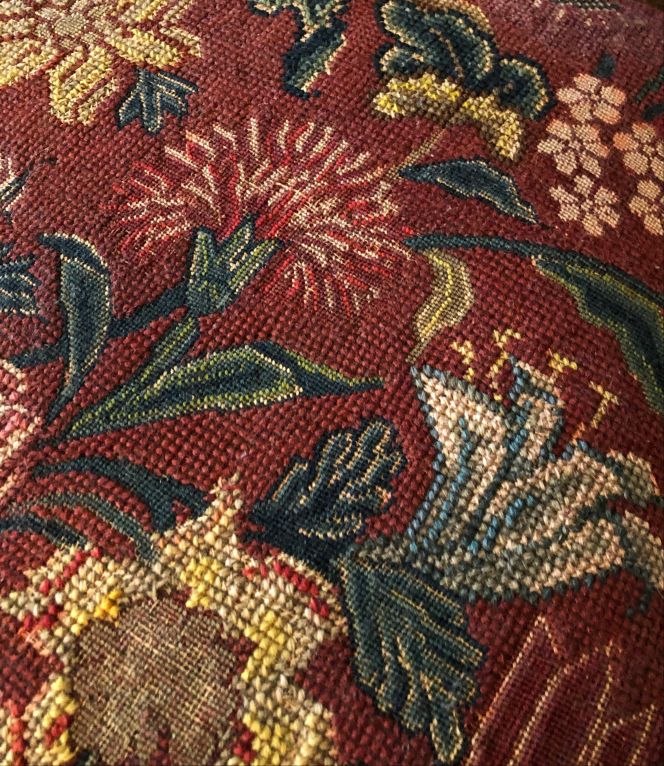 This is a close-up detail of the embroidery for original covers on two English walnut tree chairs, dating to circa 1735. Cross- and tent stitches with wool threads formed carnations, tulips and other flowering garden plants on a coarse linen canvas ground, also known as canvas-work. It is noticeable too, that some areas – of the depicted carnation for instance – were intentionally left without stitches, which intended to give the embroidery a three-layered special effect. Such embroideries were popular for upholstery on household furnishing in well-to-do and wealthy homes during the period. (Collection: David Collection in København, Denmark. No. 29a-b/1972). Photo: Viveka Hansen, The IK Foundation.
This is a close-up detail of the embroidery for original covers on two English walnut tree chairs, dating to circa 1735. Cross- and tent stitches with wool threads formed carnations, tulips and other flowering garden plants on a coarse linen canvas ground, also known as canvas-work. It is noticeable too, that some areas – of the depicted carnation for instance – were intentionally left without stitches, which intended to give the embroidery a three-layered special effect. Such embroideries were popular for upholstery on household furnishing in well-to-do and wealthy homes during the period. (Collection: David Collection in København, Denmark. No. 29a-b/1972). Photo: Viveka Hansen, The IK Foundation.-800x504.jpg) The second studied embroidery included very similar type of flowers, upholstered on an English mahogany sofa and dated to circa 1745. However, a noticeable difference between the two canvas embroideries is the fineness and density of the stitching. This illustrated upholstery, stitched with wool and some minor details of silk, is clearly much finer in quality (tent stitches over one thread of the canvas only), which gave the design a potential to be more natural in all details. One may even come to the conclusion due to its complexity, that this particular large-scale embroidery for a sofa was made by a professional embroiderer for a wealthy household. In contrast to the chair covers (illustrated above and below), which most probably could have been made by a lady during her leisure time as a beautiful handicraft for practical use in the family home. (Collection: David Collection in København, Denmark. No. 22/1971). Photo: Viveka Hansen, The IK Foundation.
The second studied embroidery included very similar type of flowers, upholstered on an English mahogany sofa and dated to circa 1745. However, a noticeable difference between the two canvas embroideries is the fineness and density of the stitching. This illustrated upholstery, stitched with wool and some minor details of silk, is clearly much finer in quality (tent stitches over one thread of the canvas only), which gave the design a potential to be more natural in all details. One may even come to the conclusion due to its complexity, that this particular large-scale embroidery for a sofa was made by a professional embroiderer for a wealthy household. In contrast to the chair covers (illustrated above and below), which most probably could have been made by a lady during her leisure time as a beautiful handicraft for practical use in the family home. (Collection: David Collection in København, Denmark. No. 22/1971). Photo: Viveka Hansen, The IK Foundation.In a reflection of my earlier research about embroideries in the coastal town of Whitby in England from 1700 to 1914, numerous primary sources revealed embroidery traditions in the local area; however, from the first century of this period, such evidence was few and, particularly for the period 1700 to 1750. This is not only because fewer women then published their experiences linked to embroidery in printed form than later, but it must also be taken into account that altogether less correspondence and other written or printed evidence have survived, and also fewer objects of textiles and the tools needed to work them, while the number of women who had the leisure to embroider as a pastime must also have been considerably smaller then. All these factors have contributed to the surviving products often being of an exclusive nature and not seldom with added silk, beads and gold, a type of embroidery that might very well have been a suitable subject for discussion in correspondence between women from prosperous homes. The subjects they embroidered also reflect their lives: pastoral scenes featuring well-off people, religious motifs, flower designs with leaf work and preferably plants of “exotic” origin like carnations, tulips, etc., scenes from the theatre or literature, and local landscapes with well-known buildings. More traces of handicrafts of these sorts are easier to find in the English counties, more densely scattered with manor houses or in London or other large cities, where the greatest number of well-to-do citizens lived their everyday lives.
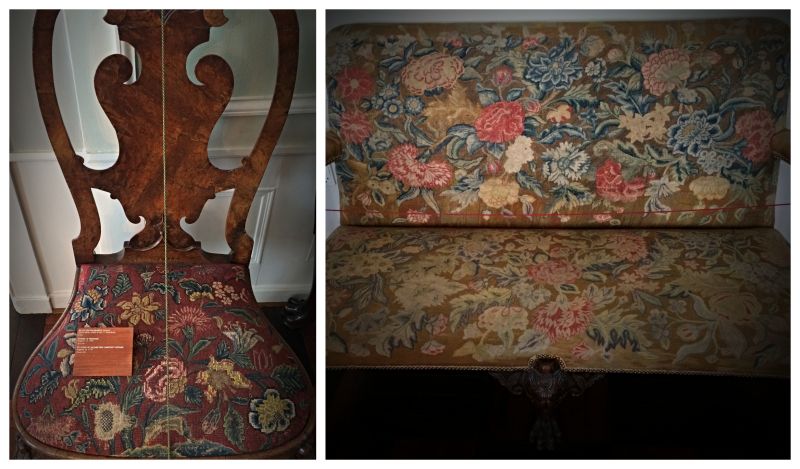 This combined picture of one of the chairs originating from around 1735 and the sofa to ten years later, among other things, clearly shows that the upholstery on the sofa has faded to a greater extent than on the two chairs with a madder (Rubia tinctoria) red ground colour, particularly visible on some of the foliage, which have turned blue. It may be noted that greens could only be made by first dyeing yellow (for instance with saw-wort, Serratula tinctoria) and then blue to get a durable result with natural dyes – and due to that the blue (woad or indigo) was the hardier of the two. This colour is often what remains on the original foliage on embroideries and tapestries of the time, which have been exposed to daylight over many decades. (Collection: David Collection in København, Denmark. No. 29a-b/1972 & No. 22/1971). Photo: Viveka Hansen, The IK Foundation.
This combined picture of one of the chairs originating from around 1735 and the sofa to ten years later, among other things, clearly shows that the upholstery on the sofa has faded to a greater extent than on the two chairs with a madder (Rubia tinctoria) red ground colour, particularly visible on some of the foliage, which have turned blue. It may be noted that greens could only be made by first dyeing yellow (for instance with saw-wort, Serratula tinctoria) and then blue to get a durable result with natural dyes – and due to that the blue (woad or indigo) was the hardier of the two. This colour is often what remains on the original foliage on embroideries and tapestries of the time, which have been exposed to daylight over many decades. (Collection: David Collection in København, Denmark. No. 29a-b/1972 & No. 22/1971). Photo: Viveka Hansen, The IK Foundation.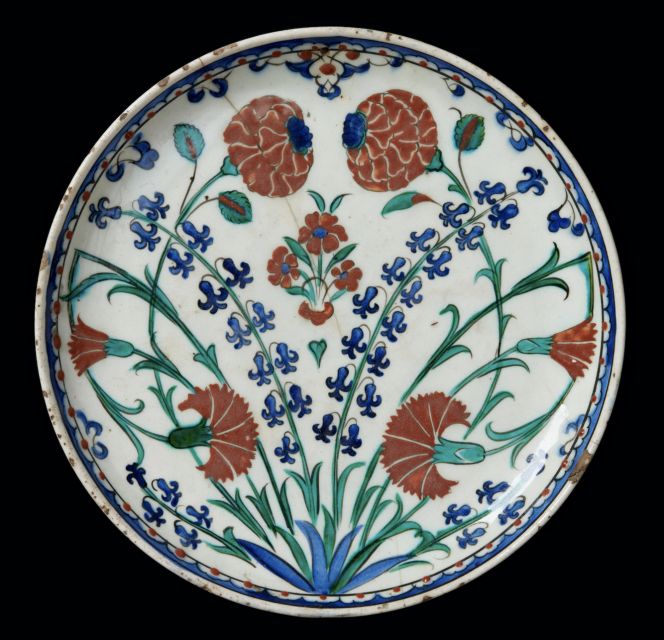 The motifs on the English embroidered upholstered furniture from the 1730s and 1740s with tulips, carnations etc., such plant motifs had had an even longer tradition in Turkey/the Ottoman Empire – from where tulips were introduced to western Europe in the 16th century. For instance stylised tulips on the finest silk fabric with silver lamella woven in the complex lampas technique has been preserved, dating from the second half of the 16th century in Turkey. Or even more similar in style compared to the much later English embroideries is this depicted pottery dish with naturalistic styled carnations, roses and hyacinths from Iznik district, circa 1575. (Courtesy: David Collection, København, Denmark. | Woven textile in text: no. 99/2005 & Depicted pottery dish: no. Isl.183).
The motifs on the English embroidered upholstered furniture from the 1730s and 1740s with tulips, carnations etc., such plant motifs had had an even longer tradition in Turkey/the Ottoman Empire – from where tulips were introduced to western Europe in the 16th century. For instance stylised tulips on the finest silk fabric with silver lamella woven in the complex lampas technique has been preserved, dating from the second half of the 16th century in Turkey. Or even more similar in style compared to the much later English embroideries is this depicted pottery dish with naturalistic styled carnations, roses and hyacinths from Iznik district, circa 1575. (Courtesy: David Collection, København, Denmark. | Woven textile in text: no. 99/2005 & Depicted pottery dish: no. Isl.183).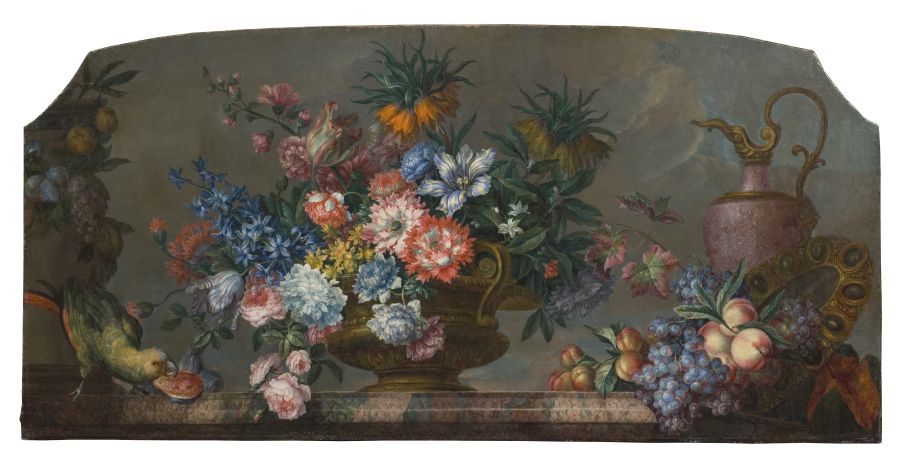 Whilst this oil on canvas is an interesting French comparison, named ’Flower piece with Vases and a Parrot’, where the artist had chosen to depict the popular flower – anemones, carnations, tulips, magnolias, peonies. The similarities in design as well as the admiration of large flowering plants in European wealthy circles are strikingly obvious – in such a painting like this and contemporary embroideries alike. Exotic features and naturalism being two of the most favoured aspects. Painting by by Antoine Monnoyer (1671-1747). (Courtesy: Nationalmuseum, Stockholm, Sweden. No. NM796, Wikimedia Commons).
Whilst this oil on canvas is an interesting French comparison, named ’Flower piece with Vases and a Parrot’, where the artist had chosen to depict the popular flower – anemones, carnations, tulips, magnolias, peonies. The similarities in design as well as the admiration of large flowering plants in European wealthy circles are strikingly obvious – in such a painting like this and contemporary embroideries alike. Exotic features and naturalism being two of the most favoured aspects. Painting by by Antoine Monnoyer (1671-1747). (Courtesy: Nationalmuseum, Stockholm, Sweden. No. NM796, Wikimedia Commons).As seen on the upholstered embroideries (on images number one to three in this essay), the tent stitch made finer details, stitched over one thread of the canvas, whilst the cross stitch was stitched over two threads on the canvas, which made a visible difference in effect. Other stitching methods used were mainly gobelin stitch, but the two first mentioned were the dominating techniques. Flowery patterns like these, with anemones, carnations, tulips, magnolias, and peonies, were evidently used in combination with garden scenes in English embroideries during the Georgian Era. Two such examples are, for instance, illustrated in Thomasina Beck’s book Gardening with Silk and Gold (pp. 98-99), where two canvas-worked chair backs were decorated with wide flower borders and centred with individually designed garden motifs. One of these motifs had been reversed in copying by the pattern-drawer from ‘The Gardener and Hog’, a motif included as an etching in the book Fables, published in 1731 by John Gay.
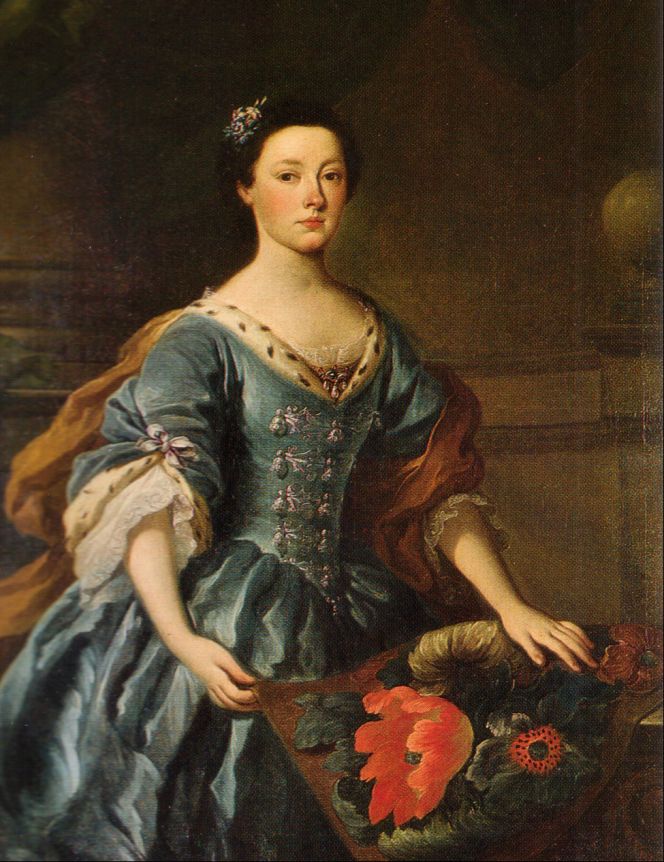 Another enlightening example of handicraft in a wealthy domestic sphere may be studied via this portrait of Jane Allgood (1721-1778) of Nunwick Hall in England. Judging by her age and fashionable silk gown, this portrait of her with a flower embroidered chair cover was painted in her youth, late 1730s to early 1740s. That is to say, contemporary with the studied embroideries at the David Collection, with the difference that this more “free style” embroidery, which depicted tulips and a variation of other flowers had been worked in long-and-short stitch in contrast to the stricter structure of the canvas-work. (Unknown collection, Wikipedia Commons. Public Domain).
Another enlightening example of handicraft in a wealthy domestic sphere may be studied via this portrait of Jane Allgood (1721-1778) of Nunwick Hall in England. Judging by her age and fashionable silk gown, this portrait of her with a flower embroidered chair cover was painted in her youth, late 1730s to early 1740s. That is to say, contemporary with the studied embroideries at the David Collection, with the difference that this more “free style” embroidery, which depicted tulips and a variation of other flowers had been worked in long-and-short stitch in contrast to the stricter structure of the canvas-work. (Unknown collection, Wikipedia Commons. Public Domain).Overall, such “freestyled” embroideries, which gave a painted illusion, equally as the stricter formed canvas-worked embroidery, were popular leisure activities in the gentry- and similar wealthy households. Mothers, daughters and other female relatives aimed to decorate, make a unique piece of textile for one’s home, save up finely made objects for the young woman’s dowry or other different reasons, but of course, not all women liked to embroider. Some women were even famous during their own lifetimes for their skills in all sorts of needlework – canvas work stitched in wool and silk included – like Mary Delany (1700-1788). The 1730s and 1740s appear to have been the decades when her interest in gardens intensified, which is visible via her meticulously detailed embroideries and sketches of garden scenes and a great variety of plants in flower. The artwork she has come to be best known for, however, was the finely made paper cuts, which mainly occupied her time later in life, from the early 1770s and onwards. During this period, she also became acquainted with the London-based naturalists Daniel Solander (1733-1782) and Joseph Banks (1743-1820), who may further have inspired her to intensify her artistic skills in this field. Interestingly, the exquisite paper-cuts show many similarities with the 18th century English canvas embroideries – both artistic media favoured anemones, carnations, tulips, magnolias, peonies and other garden plants.
It may also be noted that the reasonable rich selection of preserved evidence from the wealthy strata of society gives a somewhat misrepresented picture of 18th century embroiderers. These matters have specifically been revealed by historian Amanda Vickery in the book Behind Closed Doors: At home in Georgian England. She emphasised that: ‘Surviving objects may give the impression that amateur crafting was the preserve of the polite, but this is a misreading. Occasional detailed private inventories register art tools and sewing kit as unremarkable possessions amongst the middling’ (p. 235). The author also stressed the importance of the availability of embroidery kits and printed patterns, female duty to produce decorative textile project for the home, handicraft as a remedy for boredom, female sociability and embroidery, domestic craft as prestigious object for the home and much more aspects around the history of handicraft during the Georgian Era.
The two chair covers and the upholstered sofa – today and since many years back kept in the David Collection in Copenhagen – are small pieces of evidence which reveal details of everyday life in 18th century England when studied from a multitude of angles.
Notice: All conclusions about the embroideries on the two chair covers and upholstered sofa have been made via my close observations of stitches, material, designs, comparable textiles, etc. The museum includes the following information only: ’Two chairs of walnut with contemporary upholstery, England, c. 1735’ &. ‘Sofa of mahogany with contemporary upholstery, England, c. 1745’.| The previous essay looked in detail at ‘An Original upholstery from 1760 – A French Silk Brocade on an English Mahogany Armchair’ – from the same interior at the David Collection.
Sources:
- Beck, Thomasina, Gardening with Silk and Gold – A History of Gardens in Embroidery, UK 1997 (comparable canvas-work for chairs, pp. 98-99).
- David Collection in København, Denmark. (Exhibition: European 18th-Century Art. Two chairs: No. 29a-b/1972 & One sofa: No. 22/1971. | Research visits in February 2020 & September 2021). & Info from the museum website: for image no. 99/2005 & downloaded image no. Isl.183).
- Folsach, Kjeld von, Flora islamica: plantemotiver i islamisk kunst, Davids Samling, Købehavn 2013.
- Hansen, Viveka, The Textile History of Whitby 1700-1914..., London & Whitby 2015 (Ch. VIII. ‘Samplers and other embroideries’, pp. 311-327).
- Hayden, Ruth, Mrs Delany: Her life and her flowers, London 1992.
- Quest-Ritson, Charles, The English Garden: A Social History, London 2003.
- Vickery, Amanda, Behind Closed Doors – At Home in Georgian England, Yale 2019 (Ch. 9. 'What Women Made’. pp. 231–256. Quote: p. 235).
Essays
The iTEXTILIS is a division of The IK Workshop Society – a global and unique forum for all those interested in Natural & Cultural History from a textile Perspective.
Open Access essays, licensed under Creative Commons and freely accessible, by Textile historian Viveka Hansen, aim to integrate her current research, printed monographs, and earlier projects dating back to the late 1980s. Some essays feature rare archive material originally published in other languages, now available in English for the first time, revealing aspects of history that were previously little known outside northern European countries. Her work also explores various topics, including the textile trade, material culture, cloth manufacturing, fashion, natural dyeing, and the intriguing world of early travelling naturalists – such as the "Linnaean network" – viewed through a global historical lens.
For regular updates and to fully utilise iTEXTILIS' features, we recommend subscribing to our newsletter, iMESSENGER.
been copied to your clipboard




– a truly European organisation since 1988
Legal issues | Forget me | and much more...
You are welcome to use the information and knowledge from
The IK Workshop Society, as long as you follow a few simple rules.
LEARN MORE & I AGREE







